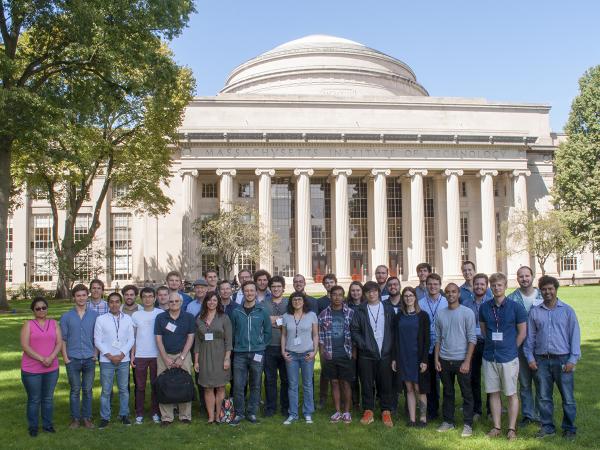
Members of the first Computational Physics School for Fusion Research
Paul Rivenberg
PSFC summer course provides analytical tools to broaden skills of young fusion researchers
September 6, 2019
The study of physics has come to rely increasingly on computers when problems cannot be solved analytically, or when there is too much data for one person to process. Traditional physics classes, however, do not often focus on teaching the computational tools that could help young scientists speed their research. To fill this gap, the MIT Plasma Science and Fusion Center hosted its first Computational Physics School for Fusion Research (CPS-FR).
Held during the final week of August, and sponsored by the Department of Energy Office of Science, the summer school provided instruction in such topics as high-performance computing, parallel programming, computational statistics and machine learning, presented by a selected pool of experts from MIT, General Atomics, Intel, Julia Comp., Lawrence Berkeley National Laboratory, University of Texas-Austin, New York University and IBM.
The school’s organizing committee led by research scientist Cristina Rea, was able to address the need for a more structured education in these topics. “A lot of us just learn on the job how to use these tools, without any formal teaching,” says graduate student Francesco Sciortino, member of the organizing team.
By acknowledging that fusion researchers often are not given any formal education on these methodologies but rather learn these by necessity, the Computational Physics School aims to address this issue and cover the gaps for the next generation of scientists.
Cristina Rea agrees that learning these tools in an unstructured environment can be problematic. “In machine learning, for example, there are many problems that can arise from bad practices or short cuts,” says Rea. “You can be so focused on getting to the end of your analysis that you might miss some important steps in laying the ground for your models to be robust. Learning the tools in a more structured way will lead to building more effective solutions.”
Having confident computing skills is important in the field of plasma science and fusion, where computer modeling is making it possible to better understand the turbulence observed in fusion plasmas, and machine learning is important for predicting plasma disruptions in tokamaks. The insight these methods provide will speed the journey to creating a working fusion furnace.
The course has attracted graduate students and postdocs from many institutions around the US, as well as some from Australia, Germany, Norway, Brazil and the UK.
Lennart Bock, who is doing his doctoral research at the Max Planck Institute for Plasma Physics (IPP) in Germany, notes that the introduction to OpenMP was especially helpful for his impurity migration studies on ASDEX Upgrade tokamak at IPP, which require a familiarity with Fortran codes.
“It’s supposed to be very good, but I never formally learned how to code in Fortran,” says Bock. “In the OpenMP class we saw how to do it in C, but also how it would look in Fortran. So now when I look at the code again I might recognize a lot of things I didn’t before. If you work in plasma physics you have to do some computing. Even if you are an experimentalist you will work with some codes to analyze your data. It’s not easy to find a summer school that combines the computational knowledge that you really need”
Nomita Vazirani, a PhD student from Virginia Tech working on simulations for inertial confinement fusion through Los Alamos National Lab, was attracted by the fusion focus of the course, particularly as applied to high-performance computing and parallel programming.
“Even the most well-trained researchers don't have a deep understanding of these topics, which can hinder your progress and sometimes lead to you spending more time on tasks that could take less time if you had more knowledge on the subject,” she says. “The courses also provided a great resource of people in the larger fusion community to network with. It was really nice to see that I was not alone in battling my learning curve with computational physics and that we could help each other learn.”
The organizers hope to offer this summer school annually to accommodate the number of young fusion scientists who want to take advantage of these analytical tools.
“There is a lot of physics in our field that has become accessible today thanks to advancements in computing,” says Sciortino. “Studies of turbulence are becoming possible now because we have these computing resources. You can’t just hope that someone will do that job for you. You have to go through the entire process of collecting the data, analyzing it and interpreting the theory. For many of us that’s the challenge.”
Rea weighs in on that: “There is a need for more cross-pollination between the fusion community and the computer scientists and applied mathematicians, in order to learn from best practices designed in such environments. We hope to lead the new generation of fusion researchers to be successful in a scientific world that is more and more shaped by such technological and algorithmic advancements.”
Topics: Magnetic fusion energy, Plasma science, Plasma theory & simulation, Anne White, Paul Bonoli